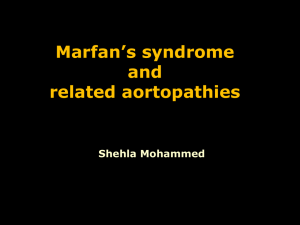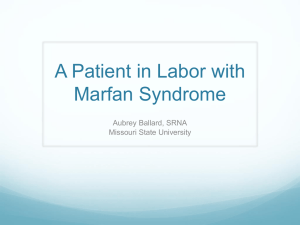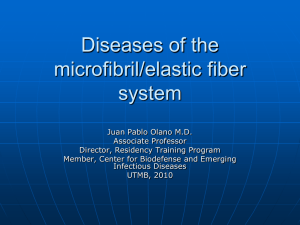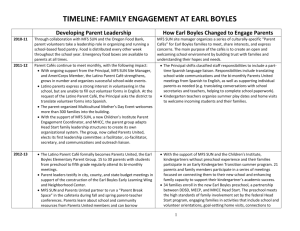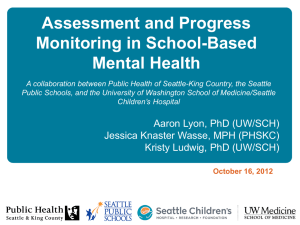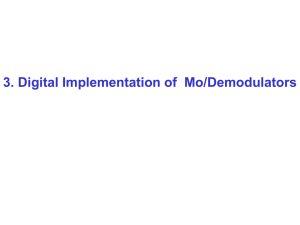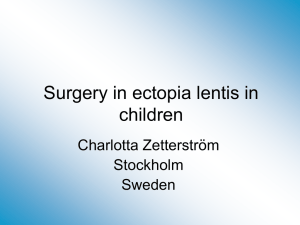Improving clinical recognition of Marfan syndrome during
advertisement
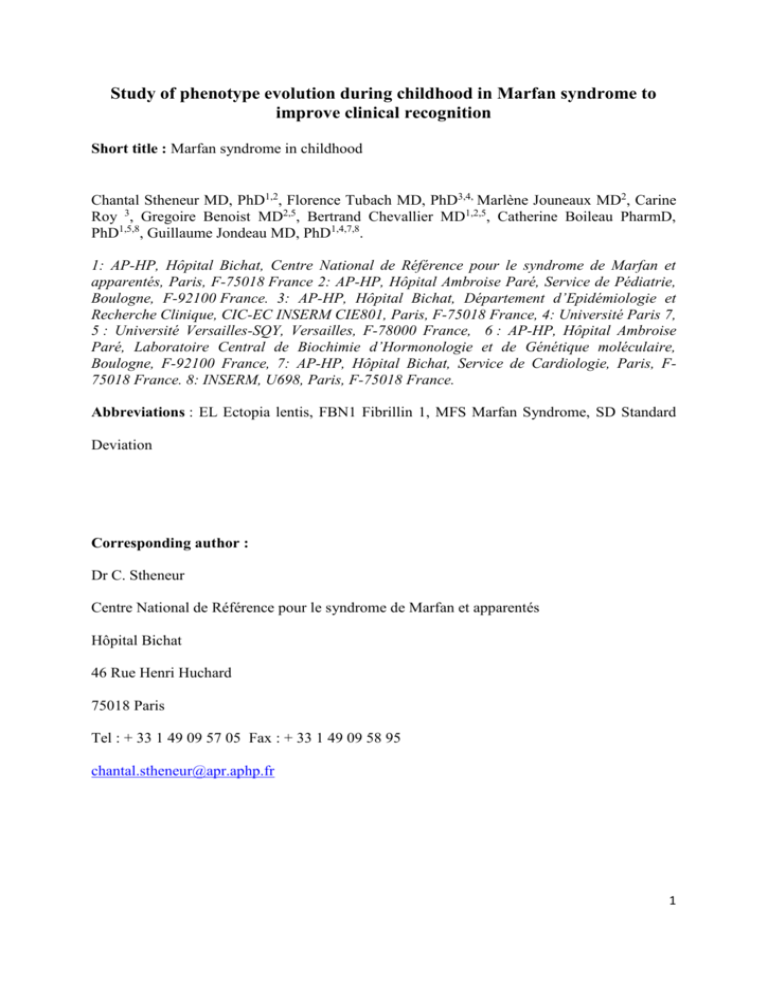
Study of phenotype evolution during childhood in Marfan syndrome to improve clinical recognition Short title : Marfan syndrome in childhood Chantal Stheneur MD, PhD1,2, Florence Tubach MD, PhD3,4, Marlène Jouneaux MD2, Carine Roy 3, Gregoire Benoist MD2,5, Bertrand Chevallier MD1,2,5, Catherine Boileau PharmD, PhD1,5,8, Guillaume Jondeau MD, PhD1,4,7,8. 1: AP-HP, Hôpital Bichat, Centre National de Référence pour le syndrome de Marfan et apparentés, Paris, F-75018 France 2: AP-HP, Hôpital Ambroise Paré, Service de Pédiatrie, Boulogne, F-92100 France. 3: AP-HP, Hôpital Bichat, Département d’Epidémiologie et Recherche Clinique, CIC-EC INSERM CIE801, Paris, F-75018 France, 4: Université Paris 7, 5 : Université Versailles-SQY, Versailles, F-78000 France, 6 : AP-HP, Hôpital Ambroise Paré, Laboratoire Central de Biochimie d’Hormonologie et de Génétique moléculaire, Boulogne, F-92100 France, 7: AP-HP, Hôpital Bichat, Service de Cardiologie, Paris, F75018 France. 8: INSERM, U698, Paris, F-75018 France. Abbreviations : EL Ectopia lentis, FBN1 Fibrillin 1, MFS Marfan Syndrome, SD Standard Deviation Corresponding author : Dr C. Stheneur Centre National de Référence pour le syndrome de Marfan et apparentés Hôpital Bichat 46 Rue Henri Huchard 75018 Paris Tel : + 33 1 49 09 57 05 Fax : + 33 1 49 09 58 95 chantal.stheneur@apr.aphp.fr 1 The authors have indicated they have no financial relationships relevant to this article to disclose The authors have no conflicts of interest relevant to this article to disclose. 2 Abstract Purpose: Because diagnosis of Marfan syndrome is difficult during infancy, we used a large cohort of children to describe the evolution of Marfan syndrome phenotype with age. Methods: 259 children carrying an FBN1 gene mutation and fulfilling Ghent criteria, were compared with 474 non MFS children. Results: Prevalence of skeletal features changed with aging: prevalence of pectus deformity increased from 43% to 62% from 0-6 years to 15-17 years, wrist signs from 28% to 67%, scoliosis from 16% to 59%. Hypermobility decreased from 67% to 47% and pes planus from 73% to 65%. Striae increased from 2% to 84%. Prevalence of ectopia lentis remained stable varying from 66% to 72%, as well as aortic root dilatation (varying from 75% to 80%). Aortic root dilatation remained stable during follow-up in this population receiving beta-blocker therapy. When comparing MFS children with non MFS children, height appeared to be a simple and discriminant criteria when height was greater than 3.3SD above the mean. Ectopia lentis and aortic dilatation were both similarly discriminating. Conclusion: Ectopia lentis and aortic dilatation are the best discriminating features, but height remains a simple discriminating variable for general practitioners when greater than 3.3SD above the mean. Mean aortic dilatation remains stable in infancy when children receive a beta-bloker. Key words: Marfan syndrome, FBN1, Childhood, international criteria 3 INTRODUCTION Marfan’s syndrome (MFS) (MIM 154700) is a connective tissue disorder with autosomal dominant inheritance caused mostly by mutations in the protein fibrillin 1 (FBN1) 1. MFS is characterized by a broad range of clinical manifestations involving the skeletal, ocular, cardiovascular, integument, pulmonary and central nervous systems with great phenotypic variability 2, 3. Cardiovascular involvement in the form of aortic aneurysm or dissecting aorta is the most serious life-threatening aspect of the syndrome. The succession of classifications (Berlin, Ghent 1 and Ghent 2) illustrates the difficulty in diagnosis 4-7 . Although the phenotype in adults is becoming well documented, data in children are much rarer because of marked phenotypic variability both between and within families, incomplete phenotype in the young limiting effectiveness of familial screening in children in the absence of molecular biology. As a consequence, child populations reported in earlier reports were possibly biased toward severe phenotypes. Our objective was to describe the evolution of Marfan syndrome phenotype with age and compare this phenotype to a population of child consulting for a suspicion of Marfan syndrome. PATIENTS AND METHODS All subjects under 18 years old who came to the French national reference outpatient clinic devoted to Marfan syndrome and related disorders (CNR Marfan) between 1995 and 2010 were considered for this study. Children came to our clinic either because they were referred by a physician for suspicion of Marfan syndrome or because they were relatives of Marfan patients (familial screening is systematic). All patients, or their relatives when under the age of 18, signed an informed consent form. Neonatal forms of Marfan syndrome were not included as they have a different prognosis and clinical picture 8. 4 In our center, patients were evaluated by a geneticist, an ophthalmologist, a cardiologist, and a pediatrician. Physical findings included skeletal features used for the diagnosis of Marfan syndrome: scoliosis, pectus deformity, pes planus, arm-span to height ratio, positive thumb and wrist sign. Systematic slit-lamp examination, cardiac ultrasonography, and radiological investigations in children older than 6 years (radiographs of pelvis, anteroposterior and lateral dorsolumbar spine, chest and left hand and wrist for evaluation of the bone age) were also performed. Besides specific Marfan features, pediatricians also checked for height and weight. The bone age was estimated during consultation and compared with the atlas of Greulich and Pyle 9. Aortic root dilatation refers to dilatation at the sinuses of valsalva. Characteristics of children are reported by age stratum (0-6 years old, 7-9 years old, 10-14 years old and 15-17 years old). Follow-up visits (yearly visits between 1995 and 2001 and a visit every two years thereafter), including the same workout, were proposed when MFS was diagnosed or could not be ruled out. FBN1 mutation screening was performed when the family mutation was already recognised (familial screening) or for diagnostic purpose when a child presented at least one major and one minor criteria, in two different systems 3. All children who fulfilled the Ghent 1 criteria at any time during their follow-up 4 were included in the “MFS group” if carrying an FBN1 gene mutation. All children evaluated during the same period in whom MFS could be ruled out either because they did not carry the familial mutation or because MFS could be definitively ruled out at the age of 18 were included in the “non MFS group”. Other children (those with undetermined status regarding MFS and those with MFS according to Ghent criteria -without FBN1 mutation) were excluded from the analysis, but the features observed in MFS according to Ghent criteria -without FBN1 mutation are reported. 5 Statistical analysis Characteristics of children during the first visit are reported by age stratum. Those characteristics are expressed by frequencies and percentages for categorical variables, and by means and SD for continuous variables. Height and weight were compared to normal value adapted from Sempe10.Comparisons between MFS children and non MFS children were performed in each stratum of age for categorical variables using chi-square or Fisher exact test as appropriate, and for continuous variables Student’s t-test or Wilcoxon rank-sum test as appropriate. Probands children were compared with non probands children using the same methodology. The significance level was 5%. To identify discriminative factors for the diagnosis of Marfan syndrome in children, potential diagnosis factors were subjected to a decision-tree–classification method based on recursive partitioning analysis. Two decision-tree models of CART type (classification and regression tree) were performed in each age stratum. Each child could contribute to more than one age stratum, but only once in each age stratum (first visit during this stratum). First the regression trees were performed by cross-validation which is a first pruning method. And then, the complexity parameter of 0.01 was used by default for all regression trees. A first model was developed including only simple clinical features available to general practitioner: height, expressed as Z score (SD above the mean), arm span over height ratio, hypermobility (Beighton scale), pectus deformity, thumb sign, wrist sign, angle of the scoliosis (in degree), and presence of striae. A second model included in addition ectopia lentis, mitral valve prolapse, and aortic diameter. Statistical analysis were performed using SAS software version 9.2 (SAS Institute Inc., Cary,NC). The classification-and-regression trees were performed with the “rpart” package, 6 which implements CART model using R software v.2.13 (The R Foundation for Statistical Computing). RESULTS Population Between 1995 and 2010, 1238 children came to the CNR Marfan. Final diagnosis was MFS for 389 children who fulfilled the Ghent criteria for MFS 4 (age at first visit was 8.6 +/- 4.7 years and 52.7% were male). Among these, 259 carried an FBN1 gene mutation (age 8.6 +/4.6 years, 51.7% male) and were included in the present study (MFS group). Age and sex ratio were similar to that of the 130 Marfan children without FBN1 mutation (age 8.6 +/- 4.9 years, 54.6% male) (MFS non FBN1 group). Marfan syndrome could be definitely ruled out in 474 children (11.43 +/-4.68 years, 56.1% male), while diagnosis remained uncertain in 375 children. Clinical presentation MFS group At first visit, 158/259 (61.0%) had a family history of MFS. One hundred and three (39.8%) children came for the first visit between 0 and 6 years old, 49 (18.9%) between 7 and 9 years old, 68 (26.2%) between 10 and 14 years old and 39 (15.1%) between 15 and 17 years old. 101 (39.0%) were probands. 2 deaths occurred before the age of 18 years, after a mean follow-up of all the patients of 3.5±3.5 years: - a 17 year old boy, 2 years after aortic dissection occurring at 15 years (aortic diameter at the sinuses of valsalva 49 mm at 14 years), 7 - a 4 year old boy 1 month post surgery (aortic valve sparing surgery and mitral valvuloplasty) Including these patients, surgery was performed in 10 children before 18 y.o: seven patients had a replacement of the ascending aorta with valvular surgery at the same time, 3 patients had mitral valve surgery alone. MFS non FBN1 group Forty eight (36.9%) children came for the first visit between 0 and 6 years old, 25 (19.2%) between 7 and 9 years old, 40 (30.8%) between 10 and 14 years old and 17 (13.1%) between 15 and 17 years old. In this population, 5 have a mutation in TGFBR2 gene and 3 a mutation in TGFBR1 gene, no mutation was found in others. Non MFS group 474 children were non MFS, including 422 children not carrying the familial mutation and 52 children not fulfilling Ghent criteria at 18 y.o. At first visit, mean age of non MFS children was higher than mean age of MFS children (11.4+/-4.7 vs 8.6+/-4.6 years) and distribution of children by age stratum was not similar in the 2 populations (p<0.0001). In contrast, sex ratio was similar (1.3 vs 1.1 (p=0.25)). Comparison between MFS group and MFS non FBN1 group for Marfan features In the MFS non FBN1 group, only scoliosis upper 10° was more frequent (75.8% vs 33.8% p<0.0001) than in MFS group. See table 2 in supplemental data. Comparison between MFS and non MFS group for Marfan features Prevalence of Marfan clinical features included in the international nosology (Ghent 1) are presented in figure 1 for both the MFS group and non MFS group and detailed by age group 8 in supplemental data. The evolution of prevalence of skeletal features in MFS children as a function of age stratum is represented in figure 2. (See supplemental data) MFS children were significantly taller than non MFS children (p<0.0001 in all age strata). At the age of 17 years, mean height was 191.2 +/- 8.4cm (+2.9 SD) in MFS boys, 190.5 +/10.9cm (2.8SD) in MFS non FBN1 group, compared to 183.6+/- 8.2 cm (+1.7SD) in non MFS boys, and 178.3 +/- 7.6 cm for MFS girls (+2.7SD), 177.8 +/- 7.7 cm (2.6SD) in MFS non FBN1 group, compared to 169.7 +/- 6.6 cm (+1.2SD) in non MFS girls. No midparental height was calculated because many parents were MFS and the predicted height cannot be thus calculated. In the whole MFS group, height more than 3.3 SD above the mean carried a positive predictive value of 72% for MFS and a negative predictive value of 79%. Arm span over height ratio was higher in the MFS children (p<0.0001 in all age stratum). It increased steadily with aging in the MFS group. Prevalence of pectus deformity, even mild pectus, was more frequent in the MFS group (p<0.0001 in all age strata). Its prevalence increased with age in the MFS group. Prevalence of thumbs sign (when young children cooperate) increased from 0-6 to 7-9 years, and remained stable thereafter. Wrist sign was more frequent in the MFS group (p<0.0001 in all age strata). Its prevalence increased between age groups 7-9 years and 10-14 years and also remained stable thereafter in the MFS group whereas it continued to increase in the non MFS group. The severity (in terms of angle) of scoliosis greatly increased with age in MFS children whereas it remained very low in the non MFS children. Prevalence of moderate scoliosis (> 10°) increased with age in both the MFS and the non MFS children, earlier in girls than in boys in both populations. Prevalence of scoliosis over 10° was 10 times greater in MFS vs. non MFS for the 0-6 years age group and nearly 3 times greater for the 15-17 years age group. Prevalence of hypermobility and pes planus tended to decrease with age, whereas striae appeared towards the age of 10 years. Both these signs were more frequent in the MFS group (p<0.0001 in all age strata). 9 Aortic root dilatation (defined as an aortic diameter above 2SD according to Roman11) was the most frequent feature (present in 80% of the MFS group) and its prevalence remained stable across age stratum; defining aortic dilatation as an aortic diameter above 3SD (as suggested in Ghent 2 criteria 5) decreased its prevalence about 10 points throughout all age classes in both the MFS group and the non MFS group. When the nomogram published by Gautier was used 12, prevalence of aortic dilatation (aortic diameter above 2SD) was 52.6 % in the MFS group, and 0.8 % in the non MFS group, also without modification with age. Similarly, ectopia lentis was present from early infancy, and its prevalence remained stable across age strata. Comparison between probands and non probands in the MFS group In the various age strata, the percentage of probands was not the same. Probands were less represented among 0-6 years (35.0%) and 10-14 years (35.3%), while they represented more than 46% in the other age strata. As expected probands were more severely affected than non probands: pectus deformity was more frequent (61.1% vs 33.3%) (p=0.007) in 0-6 years. Height was greater only in male probands at 10-14 years (4.4+/-1.2 SD above the mean vs 3.5+/-1.7) (p=0.04) and 15-17 years (3.2+/-1.2 SD above the mean vs 2.4+/-1.5) (p=0.02). Similarly, the aortic diameter was significantly greater in probands (4.8+/-2.7 SD above the mean vs 3.4+/-1.7) (p<0.0001) it is also significant by age group. Mitral valve prolapse was more frequent (72.3% vs 51.7%) (p<0.03) in 15-17 years. Aortic dilatation (defined as an aortic diameter above 2SD according to Roman) was significantly more frequent in probands in the 0-6 years, 10-14 years and 15-17 years classes. Prevalence of ectopia lentis was also greater in probands, particularly in the 0-6 and 15-17 years groups. Aortic root diameter within the MFS group 10 In MFS group, all patients were treated with beta blokers, mean aortic root diameter increased with age (24.5+/- 4.4 mm between 0 and 6 years old, 28.8 +/- 3.3 mm between 7 and 9, 33.7 +/- 5.3 between 10 and 14, 37.6 +/- 5.4 between 15 and 17). However, the importance of dilatation evaluated by the Z score using Roman nomogram remained stable (supplemental data) above the mean normal value. Discriminating features between MFS and non MFS children The features that best discriminated between MFS and non MFS children in different age class are shown in the regression trees (supplemental data). Height was the most discriminating clinical parameter in the simple clinical model with up to 65% of children correctly classified when height was above 3.3SD + mean (2.5SD for 0-6 years old children, 2.3 SD for 7-9 years old, 3.2 SD for 10-14 years old and 2.5 SD for 15-17 years old children). In a model including ophtalmological and cardiological evaluation, ectopia lentis and aortic root dilatation (defined as 3SD above the mean) were both similarly discriminating, with around 90% of children correctly classified. DISCUSSION Our work is the largest report to date of the evolution of clinical features in Marfan children carrying a mutation in the FBN1 gene. It is issued from the national reference center in France, a specialized center with large use of genetic screening. The population studied was different from previous reports which studied a small number of children (respectively 25, 22, 40 and 52 children) 13-16 with, as eligibility criteria, a former international nosology. A single study included a large number of children (320 patients) but all were probands thus excluding milder cases 17 . We thus think that the population we studied provides a better overview of 11 children affected by MFS. We chose to compare the MFS group with children consulting for suspicion of Marfan in whom MFS could be ruled out with confidence (absence of the familial FBN1 mutation or no features at the age of 18). Evolution of prevalence of skeletal features was heterogenous with the prevalence of some features increasing across age strata whereas the reverse was true for others. Because the prevalence of skeletal features varies with age, their diagnostic value varies during childhood. Wrist sign, flat feet and pectus deformity were the signs with the greatest sensitivity after the age of 10, as they have been reported in adults 18. Before 10 years, hypermobility and thumb sign were more discriminating. The difference in arm span/height ratio between the MFS and non MFS group is too small to be clinically useful, while statistically significant. Prevalence of Ghent criteria was more important in probands than in relatives especially as regards cardiovascular and ophthalmological features. Among skeletal features, only pectus deformity and arm spam to height ratio were more frequent in probands. It was anticipated that probands would be more severely affected than relatives for two reasons : 1) because children with severe mutations tend to be more seriously affected and easily recognised, and 2) severely affected patients may not reproduce as much as non severely affected patients 17. This may also be related to the fact that children in visible good health are not seeking medical advice, as well as the fact that specific skeletal features are not well known to GPs or paediatricians and thus not recognized. Interestingly, a simple parameter such as height, appeared to be discriminant between MFS and non MFS children. Height above 3.3 SD above the mean carried, in our study, a positive predictive value of 72% and a negative predictive value of 79% during childhood. It may be explained partly by statural advance, which has already been reported by others 15, 19, 20 , but has never been included in any classification, whereas our study suggests that it has a great diagnostic value. We did not take into account the parent’s height in our study but parental 12 heights should be taken into account before labeling a child as “tall”. However, an international study including more children would be necessary to definitively define the usefulness of this criterion in screening children suspected of being MFS and to define the relevant difference between observed and predicted height who has to alert the practitioner. From an ophtalmological perspective, our study, allows us to specify that EL is an early sign, what was already shown in other studies. For Maumenee et al, dislocation of lens was observed in 12.5% of Marfan children before 3 years of age and 45% in 4 to 5 years old children 21. Faivre et al find 57 % of ectopia lentis in children under 1017. From the cardiological perspective, our study confirms the previous studies which reported that 80 % of the MFS children had an aortic root dilatation using Roman’s nomograms 16, 22 . But our study specifies that this dilatation appears mostly before 6 years, and that mean aortic root diameter remained stable. Stability of the Z score is also observed when Gautier nomograms are used. Mortality, possibly related to aortic dilatation or dissection, was 1.1% up to the age of 18 years, during a relatively short mean follow up (3.5 years for the entire population) leading to a 0.3% annual mortality. This is low in comparison with other studies (range 2.8-22%) 13, 16, 22 . These observations could be partly explained by our practice of proposing beta-blokers for all children carrying a mutation in the FBN1 gene even in the absence of aortic root dilatation 22. This opinion is supported by the recent meta-analysis from Gao et al 23 which concluded that systematic prescription of beta-blockers in children with MFS limited dilatation of the aorta. However, the two most discriminating features allowing diagnosis of Marfan syndrome were ectopia lentis and aortic dilatation. If Roman nomograms are being used, it is necessary to consider an aortic root diameter limit greater than 3 SD above the mean, because of the high frequency of normal children with an aortic diameter greater than 2 SD above the mean (16 13 %). This is in keeping with the new Ghent nosology giving more importance to EL and aortic dilatation, and recommending considering aortic dilatation when greater than mean + 3 SD in childhood 5. Limitations: This study was a historical cohort. However, the data were entered prospectively and the register is exhaustive (all patients seen in the Marfan CNR are included in the register). The single center nature of this study limits the variability of evaluation of the patients and reinforces the value of data obtained during follow-up, because the measures are made by a small number of examiners. Otherwise, patients are referred from everywhere in France as this center is the National Reference Center, thus it allows for a good representation of the children in the register. Inclusion of a population with MFS and an FBN1 mutation may induce a bias toward more severe cases. But we chose to exclude the children with undetermined status regarding MFS and those with MFS according to Ghent criteria -without FBN1 mutation in order to have a more homogeneous population. The control group was a mix between relatives and children who did not meet Ghent criteria by age 18. Conclusion In conclusion, diagnostic value of skeletal features is highly variable with age, but tall stature appears to be of value for simple screening in the population. Ectopia lentis and aortic root dilatation are the best discriminating features for Marfan diagnosis in childhood. Aortic root dilatation is present early in childhood but remains stable in infancy when children receive a beta-bloker. 14 Acknowledgments This work was supported by a grant from the French Ministry of Health (grant Programme Hospitalier de Recherche Clinique 2010 AOM09093), and the Agence Nationale pour la Recherche (ANR 2010 BLAN 1129 ) Thanks to Pr P Aegerter who provided help in statistical analysis. We are grateful to Maria Tchitchinadze for her help with the database. Supplementary information is available at the Genetics in Medecine Website 15 REFERENCES 1. 2. 3. 4. 5. 6. 7. 8. 9. 10. 11. 12. 13. 14. 15. 16. 17. 18. 19. 20. 21. Faivre L, Collod-Beroud G, Loeys BL, et al. Contribution of molecular analyses in diagnosing Marfan syndrome and type I fibrillinopathies: an international study of 1009 probands. J Med Genet. Feb 29 2008. Judge DP, Dietz HC. Marfan's syndrome. Lancet. Dec 3 2005;366(9501):1965-1976. Stheneur C, Collod-Beroud G, Faivre L, et al. Identification of the minimal combination of clinical features in probands for efficient mutation detection in the FBN1 gene. Eur J Hum Genet. Mar 18 2009. De Paepe A, Devereux RB, Dietz HC, Hennekam RC, Pyeritz RE. Revised diagnostic criteria for the Marfan syndrome. Am J Med Genet. Apr 24 1996;62(4):417-426. Loeys BL, Dietz HC, Braverman AC, et al. The revised Ghent nosology for the Marfan syndrome. J Med Genet. Jul 2010;47(7):476-485. Beighton P, de Paepe A, Danks D, et al. International Nosology of Heritable Disorders of Connective Tissue, Berlin, 1986. Am J Med Genet. Mar 1988;29(3):581-594. Faivre L, Collod-Beroud G, Ades L, et al. The new Ghent criteria for Marfan syndrome: What do they change? Clin Genet. May 12 2011. Stheneur C, Faivre L, Collod-Beroud G, et al. Prognosis factors in probands with an FBN1 mutation diagnosed before the age of 1 year. Pediatr Res. Mar 2011;69(3):265-270. Greulich W, Idell Pyle S. Radiographic atlas of skeletal developpement of the hand and wrist. Standford University Press. 1950. Sempe M PG, Roy-Pernot M-P. [Auxology method and sequences]. Theraplix. 1979. Roman MJ, Devereux RB, Kramer-Fox R, O'Loughlin J. Two-dimensional echocardiographic aortic root dimensions in normal children and adults. Am J Cardiol. Sep 1 1989;64(8):507512. Gautier M, Detaint D, Fermanian C, et al. Nomograms for aortic root diameters in children using two-dimensional echocardiography. Am J Cardiol. Mar 15 2010;105(6):888-894. Geva T, Hegesh J, Frand M. The clinical course and echocardiographic features of Marfan's syndrome in childhood. Am J Dis Child. Nov 1987;141(11):1179-1182. Morse RP, Rockenmacher S, Pyeritz RE, et al. Diagnosis and management of infantile marfan syndrome. Pediatrics. Dec 1990;86(6):888-895. Lipscomb KJ, Clayton-Smith J, Harris R. Evolving phenotype of Marfan's syndrome. Arch Dis Child. Jan 1997;76(1):41-46. van Karnebeek CD, Naeff MS, Mulder BJ, Hennekam RC, Offringa M. Natural history of cardiovascular manifestations in Marfan syndrome. Arch Dis Child. Feb 2001;84(2):129-137. Faivre L, Masurel-Paulet A, Collod-Beroud G, et al. Clinical and molecular study of 320 children with Marfan syndrome and related type I fibrillinopathies in a series of 1009 probands with pathogenic FBN1 mutations. Pediatrics. Jan 2009;123(1):391-398. Sponseller PD, Erkula G, Skolasky RL, Venuti KD, Dietz HC, 3rd. Improving clinical recognition of Marfan syndrome. J Bone Joint Surg Am. Aug 4 2010;92(9):1868-1875. Vetter U, Mayerhofer R, Lang D, von Bernuth G, Ranke MB, Schmaltz AA. The Marfan syndrome--analysis of growth and cardiovascular manifestation. Eur J Pediatr. Apr 1990;149(7):452-456. Erkula G, Jones KB, Sponseller PD, Dietz HC, Pyeritz RE. Growth and maturation in Marfan syndrome. Am J Med Genet. Apr 22 2002;109(2):100-115. Maumenee IH. The eye in the Marfan syndrome. Trans Am Ophthalmol Soc. 1981;79:684733. 16 22. 23. Ladouceur M, Fermanian C, Lupoglazoff JM, et al. Effect of beta-blockade on ascending aortic dilatation in children with the Marfan syndrome. Am J Cardiol. Feb 1 2007;99(3):406-409. Gao L, Mao Q, Wen D, Zhang L, Zhou X, Hui R. The effect of beta-blocker therapy on progressive aortic dilatation in children and adolescents with Marfan's syndrome: a metaanalysis. Acta Paediatr. Sep 2011;100(9):e101-105. 17 Figure Legends Figure 1: Comparison of prevalence of different features in the Marfan and non Marfan groups. The percentages are provided for each feature and group. # : <0.05 and ≥ 0.0001 ; ‡ : <0.0001. Figure 2: Evolution of the prevalence of different features by age group in the marfan group. The percentages are provided for each feature and class of age. Comparisons were performed in each stratum of age for categorical variables using Cochrane-Armitage chi-square tests and for continuous variables Student’s t-test or Wilcoxon rank-sum test as appropriate. NS : non significant ; # : <0.05 and ≥ 0.0001 ; ‡ : <0.0001. 18
